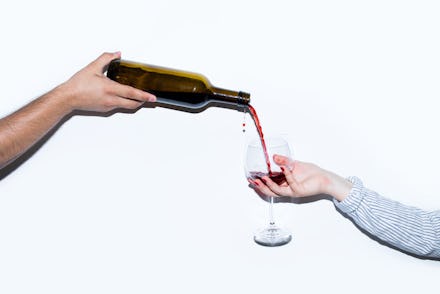Climate change is coming for your wine, too

No part of our lives — including that glass of red wine that we sedate ourselves with at the end of a long day’s news cycle — remains immune to the effects of global warming. Yes, hurricanes and tornadoes are a bit more pressing when it comes to what we should be worried about but changes in our atmosphere and soil are slowly reshaping what we consume — and that’s worth examining. This week, the New York Times reported all the ways climate change is affecting our wine, and how vineyards are learning how to make it work for them. Here are a few of the most fascinating, strange, and not-that-terrible takeaways.
Grapes can grow in more places
England has historically been know for hearty ales, not delicate bubbles but its rep is getting a lift from rising temperatures. “Thirty years ago, nobody had ever heard of English sparkling wine,” Eric Asimov wrote in the Times, “But as the climate has warmed, a world-class sparkling wine industry has developed.”
It’s not just England. Vineyards are cropping up in other places that are ordinarily too frigid to host wine grapes, like the colder countries in Europe: Norway, Sweden, Belgium, and Denmark. The local economies in these countries are getting a boon, and the world market is getting new products, like a new Riesling from Norway. I guess if there’s an upside to global warming, it’s that we’ll have more English bubbly and Norwegian Riesling to keep us placated as we hunker down for mega storms.
Wine grapes can be grown at higher altitudes
Mountainous region, for reasons listed above, haven’t always been hospitable to grapes. But the combination of the now higher temperatures and cool nights allow grapes to ripen more gradually than at lower altitudes. “Some long-established vineyard areas, once not well regarded because of their relatively high altitudes, are looking better because of climate change,” Asimov said. Part of Burgundy, for example, where the grapes would sometimes ripen too late or not at all, have now become reliable, and higher quality, wine producing regions.
Grapes now need less sun than they’re getting
Wine grapes need sunshine to ripen, but it’s problematic if they ripen too quickly or become over ripe. As a result of changing temperatures, wine makers are being forced to alter centuries-old planting methods. Grapes used to be planted on Southern facing land in the Northern Hemisphere and Northern-facing land in the Southern Hemisphere, but the upsurge in sunlight is forcing wine makers to switch things up for the first time. It’s a lot easier for newer wine regions, like the Napa Valley in California, to make these changes or for new vineyards to establish this contemporary planting logic.
The flavor of your wine might change
“The prospect of a much warmer future may require even the most famous wine regions to rethink their methods,” Asimov wrote in the Times piece. Bordeaux, for example, is a region so strict about wine that only seven grapes are allowed to grow there. But as a result of changing climate, Bordeaux’s vineyards have now proposed introducing seven new grapes to that list. This will change the flavor of wines — most notably, merlot — produced in that area.
Unpredictable weather means only resilient grapes can flourish
“Wine regions will have to learn how to deal regularly with once-rare devastations,” Asimov wrote. Drought, forest fires, and storms have always been a consideration of agriculture. The increasing frequency of these unpredictable events is changing wine production in some unexpected ways. Some pests that live on grape vines are now apparently more prevalent due to increased wetness, smoke from fires taints wines, and growers must find crops that are more drought resistant.